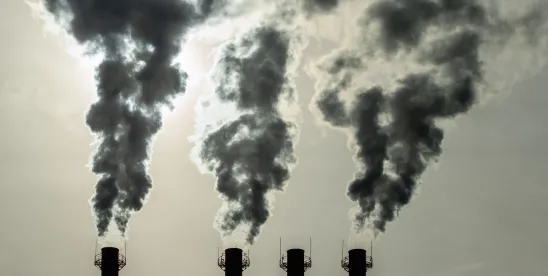On November 2, 2021, the U.S. Environmental Protection Agency (EPA) released a proposed rule that would limit emissions of methane, a greenhouse gas, from facilities in the oil and gas sector. The proposed regulations would reach hundreds of thousands of new and—for the first time—existing facilities in the production, gathering, processing, and transmission and storage segments. The proposed rule is an exercise of the EPA’s authority under section 111 of the Clean Air Act to establish “New Source Performance Standards” (NSPS) for new and modified stationary sources of air pollutants and “Emission Guidelines” for existing sources. The Biden Administration is including the EPA proposal within a multi-agency plan to reduce methane emissions from oil and gas production on federal lands and waters; abandoned coal mines; landfills; and agriculture.
The Biden Administration released its multi-agency plan in connection with a “Global Methane Pledge” announced at the 26th United Nations Climate Change Conference, known as COP26, which is currently underway in Glasgow, Scotland. Over 100 signatory nations to the pledge have agreed to a collective goal of reducing methane emissions across all sectors by 30 percent from 2020 levels by 2030.
The EPA projects that, by 2030, its proposed oil and gas sector rule would reduce methane emissions from covered facilities by 74 percent relative to their emissions in 2005. EPA further estimates that the proposed rule would reduce a total of 41 million tons of methane emissions by 2035, the equivalent of 920 million metric tons of carbon dioxide. This amount exceeds the total amount of carbon dioxide emitted from all U.S. passenger cars and commercial aircraft in 2019.
The EPA is seeking comment on the proposal. Comments will be due 60 days after publication of the proposal in the Federal Register. The EPA also will hold a public hearing 15 days after publication.
Background on Previous NPS Regulations
Federal methane regulation has been on a policy pendulum. In 2016, the Obama Administration EPA promulgated an NSPS rule addressing methane emissions from new, modified, and reconstructed facilities in the oil and gas sector. In 2020, the Trump Administration EPA rescinded the 2016 NSPS regulations, replacing them with a non-methane program that had the effect of foreclosing future methane limits for existing facilities. In 2021, Congress passed a Congressional Review Act resolution disapproving the Trump rescission, thereby reinstating the 2016 methane NSPS for new facilities and reopening the door to eventual regulation of existing facilities.
Prior to the Congressional action, President Biden issued an Executive Order directing the EPA to promulgate new methane regulations that would be more stringent than the 2016 NSPS and reach existing facilities.
Key Elements of the Proposed Rule
The proposed rule would go beyond the 2016 NSPS in both scope and stringency. Below is a summary of some of the key elements of the proposal:
Coverage of Existing Facilities. The proposed regulation would extend regulatory coverage from new facilities to over 300,000 existing facilities—in some instances, through somewhat less stringent emission controls.
The EPA proposes to regulate existing facilities pursuant to section 111(d) of the Clean Air Act, which contemplates a federal-state process. Under this process, the EPA establishes an “Emissions Guideline” setting presumptive requirements for emission controls. Then, each state submits a plan with enforceable requirements for the covered facilities within its borders. The state plans are subject to EPA review and approval.
The proposed regulation would cover facilities in the onshore production, gathering, processing, and transmission and storage segments of the oil and gas sector. The regulation would not cover facilities in the distribution segment, nor would it cover liquefied natural gas terminals.
Leak Detection and Repair. The proposal outlines a monitoring program requiring companies to detect and repair fugitive methane emissions at well sites and compressor stations. To home in on “large emitters,” the frequency of surveying would be a function of the size and types of equipment at a facility. Most sites—including all wells emitting 3 tons of methane or more per year—would be subject to a quarterly survey requirement. The EPA is co-proposing an alternative requirement that would reduce survey frequency to semi-annual for wells emitting between 3 and 8 tons per year.
Leak detection technologies have been advancing rapidly. These include aerial technologies that can cover more ground at lower cost than the optical imaging technology currently required. The proposal solicits comment on how to incorporate such innovations into the rule—whether through a voluntary “advanced measurement technology pathway” or by requiring use of some of the technologies.
Venting and Flaring. The proposed rule would eliminate venting of associated gas from oil wells and require producers to route the gas to a sales line. Producers lacking access to a sales pipeline would be required to use the gas on-site or route it to a device that reduces methane emissions by 95 percent. The proposed rule would not ban flaring, but it would require regular monitoring and timely repair of flare malfunctions.
Pneumatic Controllers. The proposal would go beyond the 2016 NSPS by mandating that all pneumatic controllers have zero emissions.
Storage Tanks. The proposed rule would extend methane reduction requirements to tank batteries (collections of tanks, flow lines, and other equipment) that are adjacent to natural gas storage tanks. Tank batteries exceeding certain levels of methane emissions would be subject to a 95 percent control requirement. The proposal also would extend leak monitoring requirements to tank hatches or openings.
Pneumatic Pumps. The EPA’s proposal would broaden the coverage of pneumatic pumps across regulated segments, requiring a greater number and variety of such pumps to reduce emissions by 95 percent. The proposal also solicits comments on the feasibility of requiring the use of zero-emitting pneumatic pumps at facilities that have access to electricity.
Supplemental Proposal in 2022. The EPA says it intends to issue a supplemental proposal next year that will include proposed regulatory text and potential further modifications based on public input. To this end, the proposal seeks information on additional measures, including for abandoned and unplugged wells, flares, pipeline “pigging” operations, and tank truck loading operations. The EPA is also soliciting ideas on how to empower communities neighboring oil and gas facilities to monitor and report large emission events.
Other Methane Policy Initiatives
In addition to EPA’s proposed rule, there are several other methane policy initiatives currently underway. Below is a summary:
Methane Fee Legislation. Democrats in Congress are currently negotiating a budget reconciliation bill known as the “Build Back Better Act.” The November 3rd Manager’s Amendment to the House Rules Committee print of the legislation includes a provision that would impose charges on oil and gas facilities for their methane emissions. Under the draft text, the EPA would levy “methane fees” starting at $900 per ton in 2023, increasing to $1,200 in 2024 and then $1,500 in 2025 and each year thereafter. The fee would apply to each ton of methane emissions in excess of 0.2 percent of the gas sold by the facility. For oil facilities not selling gas, the fee would apply to emissions in excess of 10 metric tons per million barrels of oil. The fee would not only apply to onshore facilities but also to offshore facilities. The provision is silent on how the fee would interact with any EPA methane regulation. The fate of the methane fee is uncertain at this time.
PHMSA Policies. On the same day that the EPA issued its proposed methane rule, the Pipeline and Hazardous Safety Materials Administration (PHMSA) finalized a rule expanding safety oversight to hundreds of thousands of miles of previously unregulated onshore gathering lines. The rule would require the pipelines to submit annual reports and leak incident reports. According to PHMSA, over 1,000 metric tons of methane are lost, on average, with each pipeline rupture—and a single rupture from a large, high-pressure gas pipeline can release more than 1,300 metric tons. In addition, as required under Section 113 of the PIPES Act of 2020, PHMSA has begun to consider new leak detection and repair regulations intended to reduce methane emissions from new and existing gas transmission, gas distribution, and certain onshore gas gathering pipeline facilities. Even before these new regulations are adopted, pipeline operators are required to revise their inspection and maintenance plans to eliminate hazardous leaks, minimize natural gas releases from pipeline facilities, and replace and remediate pipelines known to leak.
Future BLM and BOEM Policies. According to the multi-agency plan released on November 1, the Department of Interior intends to enhance methane controls for operations on federal lands. The Bureau of Land Management (BLM) is planning to issue a regulation that would disincentivize excess venting and flaring by requiring operators to pay royalties for vented and flared gas. In addition, BLM and the Bureau of Ocean Energy Management (BOEM) intend to strengthen “financial assurance” requirements for operators, in order to ensure that decommissioned wells are properly plugged and reclaimed.
State Methane Policies. Multiple states have established their own methane regulatory policies in recent years. In the proposed rule, the EPA asserts that states will be able to leverage these regulations in the plans they submit to comply with the Emissions Guideline.
Voluntary Methane Initiatives. In recent years, many individual companies and industry trade groups have adopted voluntary methane reduction commitments. Complementing these efforts have been such cross-segment initiatives as the Oil and Gas Methane Partnership, ONE Future, the Oil and Gas Climate Initiative, and the Natural Gas Supply Initiative. In addition, a number of organizations a third -party certification process to establish the “green” quality of oil and gas. Companies participating in such efforts will need to analyze the extent to which their voluntary commitments and certifications correspond to the requirements in the proposed rule—including voluntary commitments and certifications framed in terms of reductions in overall methane intensity (emissions per unit gas throughput) rather than the types of equipment-specific requirements specified in the proposed rule
Supreme Court Proceeding Poses Potential Roadblock
On October 29th, the Supreme Court took up a case that could affect the proposed methane rule. The Court granted cert on a set of consolidated legal challenges to a decision of the Court of Appeals for the District of Columbia Circuit (D.C. Circuit) invalidating a section 111 rule promulgated by the Trump EPA. The Trump EPA rule established carbon dioxide emission limits for existing power plants. It is possible that the Supreme Court will confine its review to the design of the power plant rule. However, the challengers have also asked the Supreme Court to consider whether, in the context of greenhouse gas emissions, section 111 represents an overly broad, unconstitutional delegation of power by Congress to the Executive Branch. Such a ruling could affect the proposed methane rule. A decision is expected in Summer 2022.







 />i
/>i

